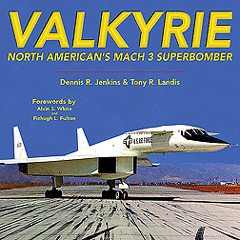

By Terry Miesle - © 2005
I still remember my first glimpse of the XB-70 Valkyrie. Growing up in Cincinnati, my family visited the USAF Museum in Dayton occasionally. As you approach the museum, you pass the familiar F-104 gate guard, then turn another bend and see the front of the museum. On the tarmac all those years ago a lot of aircraft stood in the weather, waiting for eventual museum expansions. |
 |
|
Among these was the Valkyrie. A huge white aircraft loomed on the pavement, a smaller white aircraft next to it, and even smaller aircraft surrounding those. And it was. It reminded me of a pterodactyl, with its long neck and canard wings, delta layout, and unworldly look. It was a dinosaur, a relic of an earlier, perhaps more ambitious age. Certainly it was a museum piece by the late 1970s, and a truly significant piece of American aviation history. What You Get Specialty Press' large book about the XB-70 is about the most definitive tome you could ask for. It's a cross between history, reference, and coffee-table book. Major sections include discussions covering America's pursuit of an atomic-powered bomber which would stay aloft for months, the potential development of a Mach-3 fighter, the politics of the supersonic bomber era, development of the Valkyrie, the conclusion that the aircraft might not be practical or even needed, and finally the use of the Valkyrie as an experimental platform and how this research applied to future supersonic transport. When you leaf through the first third of the book, you'll see the state of aeronautics in the 1950s and 1960s. The B-36, while certainly capable of its mission, was vunerable to the growing threat from jet fighter interception. Parasite fighters, extra speed, extra altitude, and ever-increasing range all contributed to increasing the capability of the Peacekeeper. Still, this was not enough. Faster aircraft like the B-47 and later the B-58 Hustler provided supersonic bomber capability. Still, this was not enough. The USAF directed Boeing and North American to develop new ideas for Mach 3 bombers, and pursued a parallel Mach 3 fighter program. To me, reviewing the Boeing designs, I wondered whether they employed Gerry Anderson. Many of the designs look like aircraft from the Thunderbirds with wild, swooping wings and more engines than one would think practical. Power was everything. North American settled on a layout very much like the eventual Valkyrie relatively early. Though, saying that, I would be remiss to not mention some of the wilder ideas like floating wingtip fuel tanks. These were wing extensions containing what were essentially secondary fuselages containing little more than fuel. Once expended, these small aircraft would detach and glide back home or to some other airstrip. Wing coupling proved quite dangerous, and no effective way to deal with the incredible stresses at the wingtips was ever devised. Mid-air refueling would prove to be a much more effective solution. So, what's here for the modeler? History, particularly a wealth of pictures from the XF-103 and XF-108 programs, and of course the Valkyrie program itself. This is when the escape capsule was first designed. Ejecting at supersonic speeds is no more safe than staying in the disintegrating aircraft itself. The XV-103 program built a capsule, and tested it. This was also integrated into the XB-70, which also used the technology. However, that time it was for real. One of the two Valkyries crashed following a mid-air collision with an F-104. Carl Cross, one of the Valkyrie pilots, and Joseph Walker, pilot of the F-104 both died in the crash. Al White, the second Valkyrie pilot nearly didn't make it out when his arm was caught in the closing capsule. Eventually he was able to eject the capsule and survived the incident. Because the capsule was not properly closed, the airbags beneath the capsule never inflated and White impacted the ground at a 44g force. Dennis Jenkins and Tony Landis have provided us with so much astounding information only through years of research, trying to find company records and information after several mergers was not easy, and much may have been lost through the years. This book is a significant collection of the remaining archives, and is well-punctuated with first-hand information. Forwards from Al White and Fitzhugh Fulton, Jr. provide pilot views of the aircraft and in some ways set the businesslike tone of a test pilot. Conclusions I really can't recommend this book highly enough. If you're a fan of the X-planes, a student of history, or a modeler with an eye for the internal workings of aircraft engineering, you'll enjoy this book. People who visit your house and begin leafing through the book will be quickly hooked on the fantastic hypothetical designs from Boeing and North American and of course the wealth of photographs. Many thanks to the folks at Specialty Press for the review sample. |
![]()
This page copyright © 2005 Starship Modeler™. First posted on 24 January 2005.